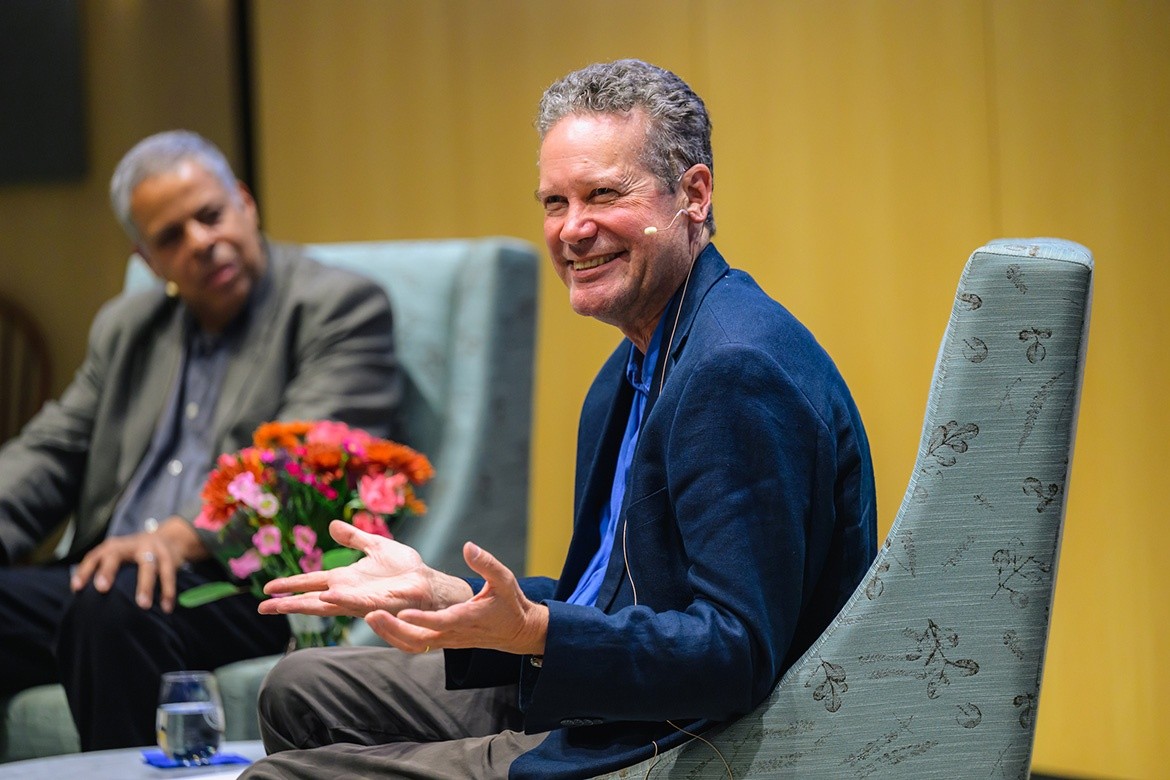Connecting art and music through Anni Albers

Mount Holyoke College Art Museum (MHCAM) hosted a panel to celebrate the artist Anni Albers. An exhibition of Albers’ work will be on view through Dec. 9, 2025.
Mount Holyoke College Art Museum (MHCAM) hosted a panel to celebrate the artist Anni Albers. Albers, one of the most famous textile and print artists of the twentieth century, was great-aunt to Christopher Benfey, professor emeritus of English at Mount Holyoke College.
MHCAM has an exhibition of Albers’ work, “Anni’s Orchestra: Theme and Variation in the Prints of Anni Albers,” that will be on view through Dec. 9, 2025.
Benfey and composer David W. Sanford, Elizabeth T. Kennan Professor of Music, discussed how Albers’ works, specifically her Orchestra print series, were inspired by music.
Benfey was instrumental in getting Albers’ works to MHC. In 2005, Benfey and Curator Wendy Watson went to the Joseph and Anni Albers Foundation in Connecticut, and the foundation gifted 12 prints to MHCAM. This year is the first time they are on exhibition.
“They are rarely on view,” Museum Associate Director for Engagement Ellen Alvord explained. “Works on paper are sensitive to light, so they cannot be on view for long periods of time.”
Alvord and Benfey were excited to discuss Albers’ prints in the panel discussion, which focused on the four prints that make up the “Orchestra” series. Through the Orchestra works, Albers’ focus on theme and variation comes to life.
“You can see it in the Orchestra series, where she’s playing around with a similar theme or motif, and then she’s altering it and varying it or riffing off of it,” Alvord said. “It feels very musical, and you can get a feel for how music was also important in her life.”
“In Anni’s Orchestra series, theme and variation are both the subject of the piece and the method of the series,” Benfey said.
Her family’s tradition of listening to Bach’s Goldberg Variations on Christmas Eve provided a lot of Albers’ inspiration around theme and variation. According to Albers’ family, her time in Berlin as a young girl, when she would go to the opera with her family, provided another inspiration for her Orchestra prints.
“Her favorite part, she recalls, was when the orchestra was tuning up,” Alvord said. “She loved hearing all of the different instruments coming into tune and that kind of sense of excitement, but also, she was always interested in the process [of tuning up].”
All this inspiration culminated in her Orchestra series, as well as her Theme and Variations series and her Sand or Sound series.
Students from the Mount Holyoke Symphony Orchestra were invited to come in and perform composer John Cage’s Atlas-Eclipticalis during the panel to highlight Albers’ interest in music.
The students were dispersed around the room as they performed, creating a surround sound for the audience while acting on Cage’s ideas of having the orchestra conducted in the round, with the conductor acting as the center and the hands of a clock. Cage, a friend of Albers, was inspired by astronomers’ star charts while writing this piece.
Throughout the discussion, Sanford played various musical clips that illustrated theme and variation to help bring the idea to life from a perspective other than visual art.
“Once you notice [theme and variation] is there, a whole world opens up,” Sanford said.
Sanford and Benfey encouraged people to approach theme and variation from a new angle and to explore the opportunities for creativity available within these ideas. They hoped that people would enjoy looking at Albers’ work and seeing how she explored these ideas in a unique way.
Alvord believes that this panel and exhibit will teach more people about the inspirational person that Albers was.
“Anni was beloved,” Alvord said. “She was this irrepressible spirit, and she was very interdisciplinary as well, which is exactly what we want to keep alive at Mount Holyoke.”
